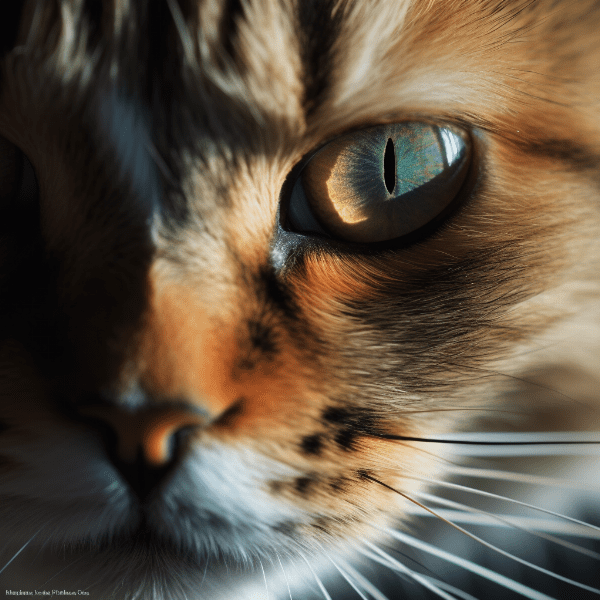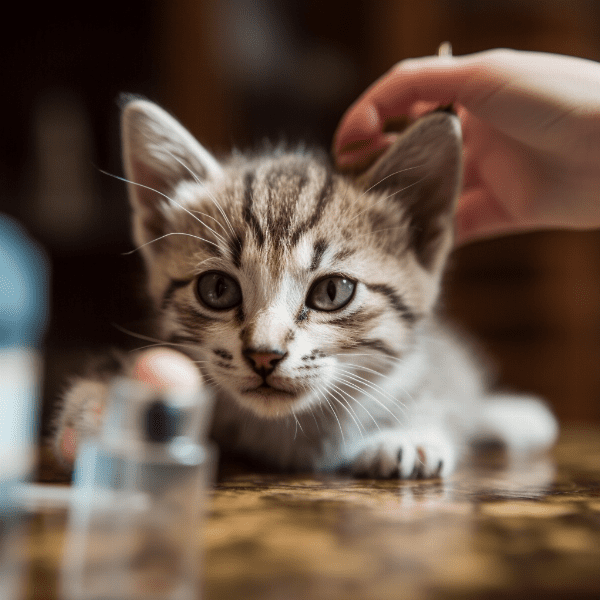Table of Contents
- What is Cat Scratch Disease?
- How is Cat Scratch Disease Transmitted?
- Symptoms of Cat Scratch Disease Eye Infection
- Diagnosis of Cat Scratch Disease Eye Infection
- Treatment Options for Cat Scratch Disease Eye Infection
- Prevention of Cat Scratch Disease Eye Infection
- When to Seek Medical Attention
- Possible Complications of Cat Scratch Disease Eye Infection
- Living with Cat Scratch Disease Eye Infection
- Conclusion
What is Cat Scratch Disease?
Cat Scratch Disease (CSD) is an infection caused by the bacterium Bartonella henselae. The disease is usually spread through a scratch or bite from an infected cat, although fleas can also transmit the bacteria.
The Origin of the Disease
The disease was first discovered in 1950 when a doctor noticed a link between a patient’s symptoms and a cat scratch. It wasn’t until the 1980s that the specific bacterium causing the disease was identified.
Who is at Risk?
CSD is most commonly seen in children and young adults, especially those who have regular contact with cats. Outdoor cats are more likely to carry the bacteria, so people who live in rural areas or spend time in outdoor activities are at a higher risk of contracting the disease.
How the Disease Progresses
The bacteria enter the body through a scratch or bite from an infected cat or flea. They then multiply and cause swelling and inflammation of the lymph nodes near the site of infection. Symptoms may appear within a few days or up to several weeks after infection.
Is it Contagious?
CSD is not contagious between humans, and it can only be spread through contact with an infected cat or flea. The disease is usually mild and resolves on its own within a few weeks, but in rare cases, it can lead to more severe complications.
Understanding what Cat Scratch Disease is and how it is spread is important for anyone who has regular contact with cats or lives in an area with a high population of outdoor cats. By taking preventative measures, such as washing cat scratches or bites with soap and water and avoiding rough play with cats, you can reduce the risk of contracting this disease.
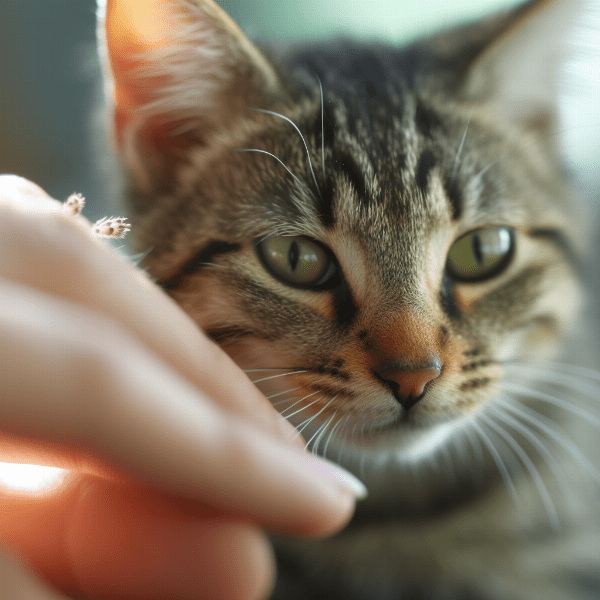
How is Cat Scratch Disease Transmitted?
Cat Scratch Disease is caused by the bacterium Bartonella henselae, which can be found in the saliva of infected cats. The bacteria can enter the human body through scratches or bites from an infected cat or through contact with cat fleas.
Scratches and Bites
When a cat scratches or bites a person, bacteria from the cat’s saliva can enter the wound and cause an infection. While any cat can carry the bacteria, kittens are more likely to have it and to scratch and bite more frequently during play.
Flea Bites
Fleas can also transmit the bacteria that causes CSD. When an infected flea bites a cat, it can ingest the bacteria in the cat’s blood. When the flea later bites a human, it can regurgitate the bacteria into the bite wound, leading to infection.
Other Methods of Transmission
While scratches and flea bites are the most common methods of transmission, it is also possible to contract CSD from other types of contact with cats. For example, if an infected cat licks an open wound or a person’s eye, the bacteria can enter the body through these routes as well.
Knowing how CSD is transmitted is crucial for preventing infection. By taking steps to avoid being scratched or bitten by cats, such as not engaging in rough play, and regularly treating cats for fleas, you can reduce your risk of contracting this disease.
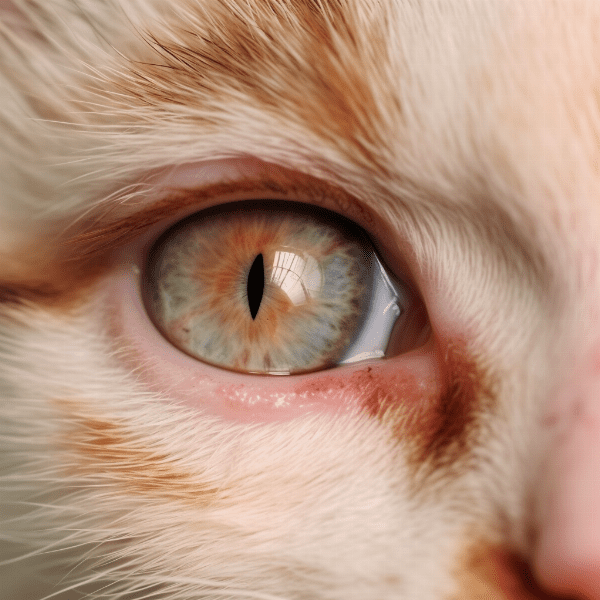
Symptoms of Cat Scratch Disease Eye Infection
When the bacterium Bartonella henselae enters the body through a scratch or bite from an infected cat or flea, it can lead to a range of symptoms, including an eye infection.
Eye Infection Symptoms
An eye infection caused by Cat Scratch Disease may cause the following symptoms:
- Redness and swelling of the eye and surrounding tissue
- Tearing or discharge from the eye
- Sensitivity to light
- Blurred or decreased vision
- Pain or discomfort in or around the eye
General Symptoms
In addition to eye infection symptoms, people with CSD may experience the following general symptoms:
- Swollen and tender lymph nodes, particularly around the head, neck, and upper limbs
- Fatigue and malaise
- Fever
Symptoms of Cat Scratch Disease can vary in severity and duration. In some cases, the symptoms may be mild and resolve on their own within a few weeks. In other cases, the symptoms may be more severe and require medical attention.
If you suspect that you have an eye infection or are experiencing any symptoms of Cat Scratch Disease, it is important to seek medical attention. Early treatment can help prevent the spread of the infection and reduce the risk of complications.
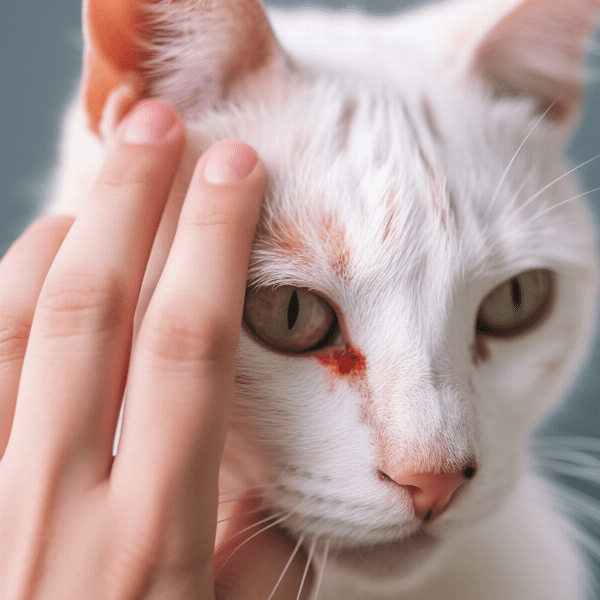
Diagnosis of Cat Scratch Disease Eye Infection
If you are experiencing symptoms of Cat Scratch Disease, including an eye infection, your healthcare provider may perform a physical exam and review your medical history to make a diagnosis.
Physical Exam
During a physical exam, your healthcare provider will examine your eye and look for signs of infection, such as redness, swelling, or discharge. They may also check your lymph nodes for swelling and tenderness, as this is a common symptom of Cat Scratch Disease.
Blood Tests
Blood tests may be performed to check for antibodies to the bacteria that causes Cat Scratch Disease. These antibodies are produced by the immune system in response to the infection and can be detected in the blood. However, it may take several weeks for the antibodies to show up in the blood after infection, so this test may not be helpful in early diagnosis.
Biopsy
In rare cases, a biopsy of the lymph node may be performed to confirm a diagnosis of Cat Scratch Disease. During a biopsy, a small sample of tissue is removed from the lymph node and examined under a microscope for signs of infection.
Diagnosing Cat Scratch Disease, including an eye infection, can be challenging because the symptoms can be similar to other conditions. However, early diagnosis is important for effective treatment and to prevent complications. If you are experiencing symptoms, it is important to see a healthcare provider for an accurate diagnosis.

Treatment Options for Cat Scratch Disease Eye Infection
If you are diagnosed with an eye infection caused by Cat Scratch Disease, there are several treatment options available.
Antibiotics
Antibiotics may be prescribed to treat Cat Scratch Disease, particularly in cases where the infection is severe or has spread beyond the lymph nodes. Antibiotics are effective in treating the bacterial infection and may be taken for several weeks. It is important to complete the entire course of antibiotics, even if symptoms improve, to ensure the infection is fully treated.
Eye Drops
Eye drops may be prescribed to relieve symptoms of the eye infection, such as redness, swelling, or discharge.
Warm Compresses
Warm compresses may help relieve symptoms of the eye infection and promote healing. Apply a warm compress to the affected eye for 10-15 minutes several times a day.
Rest and Fluids
Resting and staying hydrated can also help the body fight the infection and promote healing.
Most cases of Cat Scratch Disease, including eye infections, will resolve on their own without treatment within a few weeks. However, in some cases, treatment may be necessary to relieve symptoms and prevent complications. If you are experiencing symptoms of Cat Scratch Disease, including an eye infection, talk to your healthcare provider about the best treatment options for your individual case.
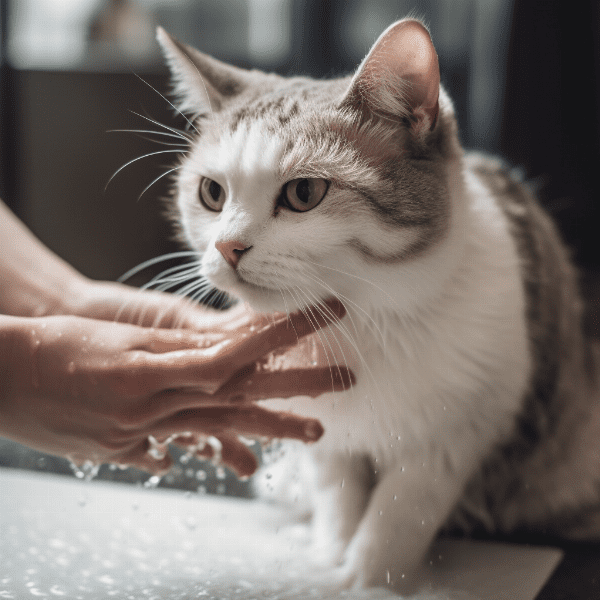
Prevention of Cat Scratch Disease Eye Infection
Preventing Cat Scratch Disease, including eye infections, can be done by taking a few simple steps.
Avoid Rough Play
Avoid rough play with cats, as this can increase the risk of scratches and bites. Teach children to handle cats gently and avoid pulling their tails or ears.
Wash Scratches and Bites
If you are scratched or bitten by a cat, wash the area thoroughly with soap and water as soon as possible. This can help reduce the risk of infection.
Keep Cats Indoors
Keeping cats indoors can reduce their exposure to fleas and other animals that may carry the bacteria that causes Cat Scratch Disease. It also reduces their risk of getting into fights with other cats, which can increase the risk of scratches and bites.
Treat Fleas
Regularly treating cats for fleas can help reduce the risk of the bacteria being transmitted to humans. Talk to your veterinarian about the best flea prevention methods for your cat.
Wear Gloves
If you are handling a cat that is known to scratch or bite, wear gloves to reduce the risk of injury.
Taking steps to prevent Cat Scratch Disease, including eye infections, can help reduce the risk of infection. By being mindful of how you interact with cats and taking preventative measures, you can reduce the likelihood of contracting this disease.
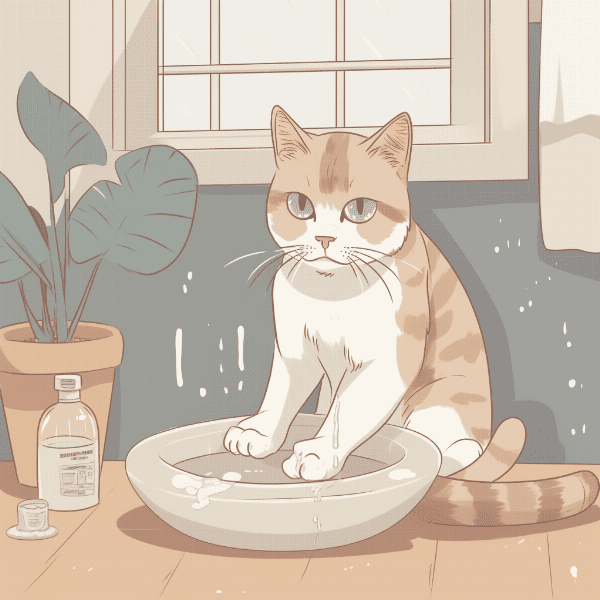
When to Seek Medical Attention
If you have been scratched or bitten by a cat or are experiencing symptoms of Cat Scratch Disease, including an eye infection, it is important to know when to seek medical attention.
Symptoms to Watch For
Symptoms of Cat Scratch Disease can vary in severity and duration, but some symptoms may warrant immediate medical attention, including:
- High fever
- Severe headache
- Severe swelling or redness around the site of the scratch or bite
- Symptoms that persist for more than a few weeks
Seeking Medical Attention
If you are experiencing any of the symptoms above, or if you are concerned about your condition, it is important to seek medical attention. Your healthcare provider can perform a physical exam and order any necessary tests to determine the cause of your symptoms.
Complications
In rare cases, Cat Scratch Disease can lead to complications, such as infections in the liver, spleen, or central nervous system. If left untreated, these complications can be serious. It is important to seek medical attention if you suspect you may have Cat Scratch Disease.
Knowing when to seek medical attention is crucial for effective treatment and to prevent complications. If you are experiencing symptoms or have been scratched or bitten by a cat, talk to your healthcare provider to determine the best course of action.

Possible Complications of Cat Scratch Disease Eye Infection
Most cases of Cat Scratch Disease, including eye infections, will resolve on their own within a few weeks and do not lead to complications. However, in rare cases, complications can occur.
Neuroretinitis
Neuroretinitis is a rare complication of Cat Scratch Disease that can cause vision loss in one eye. It occurs when the bacteria that causes the disease spreads to the optic nerve, causing inflammation and damage.
Parinaud’s Oculoglandular Syndrome
Parinaud’s Oculoglandular Syndrome is another rare complication of Cat Scratch Disease that affects the eye. It causes redness and swelling of the eye and surrounding tissue, as well as swelling of the lymph nodes near the eye.
Systemic Infection
In rare cases, the bacteria that causes Cat Scratch Disease can spread to other parts of the body, leading to systemic infection. This can cause fever, fatigue, and swelling of the liver or spleen.
While complications of Cat Scratch Disease are rare, it is important to seek medical attention if you are experiencing symptoms of an eye infection or any other symptoms of the disease. Early treatment can help prevent the spread of the infection and reduce the risk of complications. If you are concerned about your symptoms, talk to your healthcare provider about the best course of action.
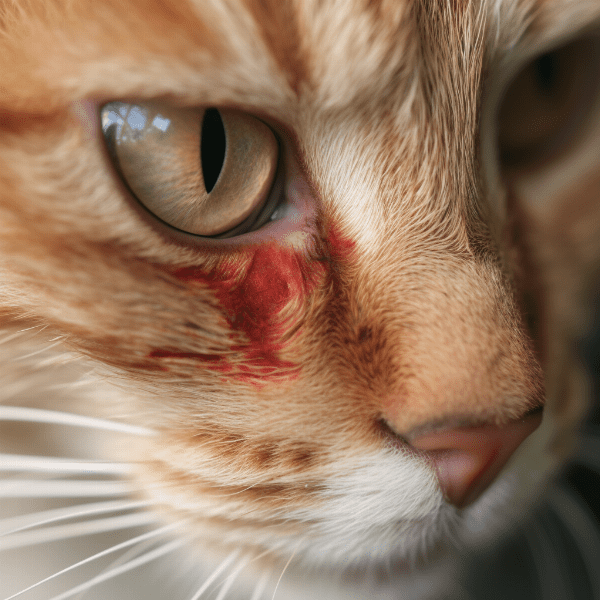
Living with Cat Scratch Disease Eye Infection
Most cases of Cat Scratch Disease, including eye infections, will resolve on their own within a few weeks without any long-term effects. However, there are some things you can do to manage your symptoms and promote healing.
Rest and Hydration
Resting and staying hydrated can help your body fight the infection and promote healing. It is important to get plenty of rest and drink plenty of fluids, especially water, to stay hydrated.
Pain Relief
Over-the-counter pain relievers, such as acetaminophen or ibuprofen, can help relieve pain or discomfort associated with the infection. Follow the instructions on the label and do not exceed the recommended dose.
Follow Medical Advice
If your healthcare provider prescribes antibiotics or other medications, it is important to follow their instructions carefully. Take all of the medication as directed, even if you start feeling better before the medication is finished.
Take Care of Your Eye
If you have an eye infection, it is important to take care of your eye to prevent further irritation or infection. Use eye drops as prescribed and avoid rubbing or touching your eye.
Avoid Contact Sports
If you have an active infection, it is important to avoid contact sports or other activities that may lead to injury or further irritation of the affected area.
Living with Cat Scratch Disease, including an eye infection, can be uncomfortable, but most cases will resolve on their own without any long-term effects. By following medical advice and taking steps to manage your symptoms, you can promote healing and reduce the risk of complications. If you have any concerns or questions about living with Cat Scratch Disease, talk to your healthcare provider.

Conclusion
Cat Scratch Disease is a bacterial infection that can be transmitted to humans through scratches or bites from infected cats or contact with cat fleas. While most cases will resolve on their own within a few weeks, it is important to seek medical attention if you are experiencing symptoms or have been scratched or bitten by a cat.
An eye infection is one possible symptom of Cat Scratch Disease, and it can cause redness, swelling, discharge, and pain or discomfort in or around the eye. If you suspect you may have an eye infection, it is important to seek medical attention.
Preventing Cat Scratch Disease, including eye infections, can be done by taking simple steps, such as avoiding rough play with cats, washing scratches and bites immediately, keeping cats indoors, treating fleas, and wearing gloves when handling cats known to scratch or bite.
While complications of Cat Scratch Disease are rare, it is important to be aware of possible complications, such as neuroretinitis, Parinaud’s Oculoglandular Syndrome, and systemic infection.
By taking steps to prevent Cat Scratch Disease and seeking medical attention if needed, you can reduce your risk of infection and promote healing if you do become infected.


